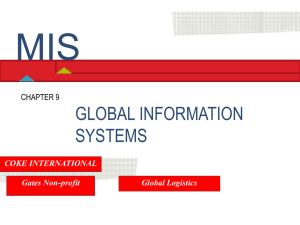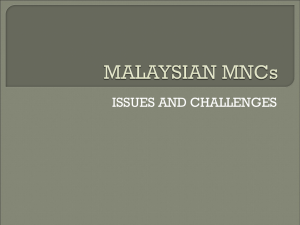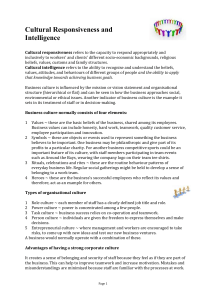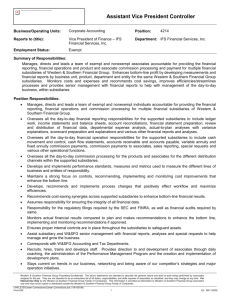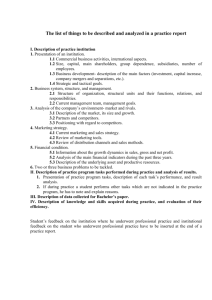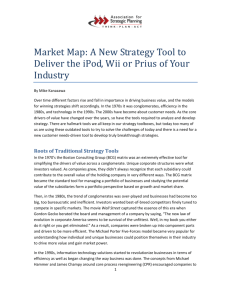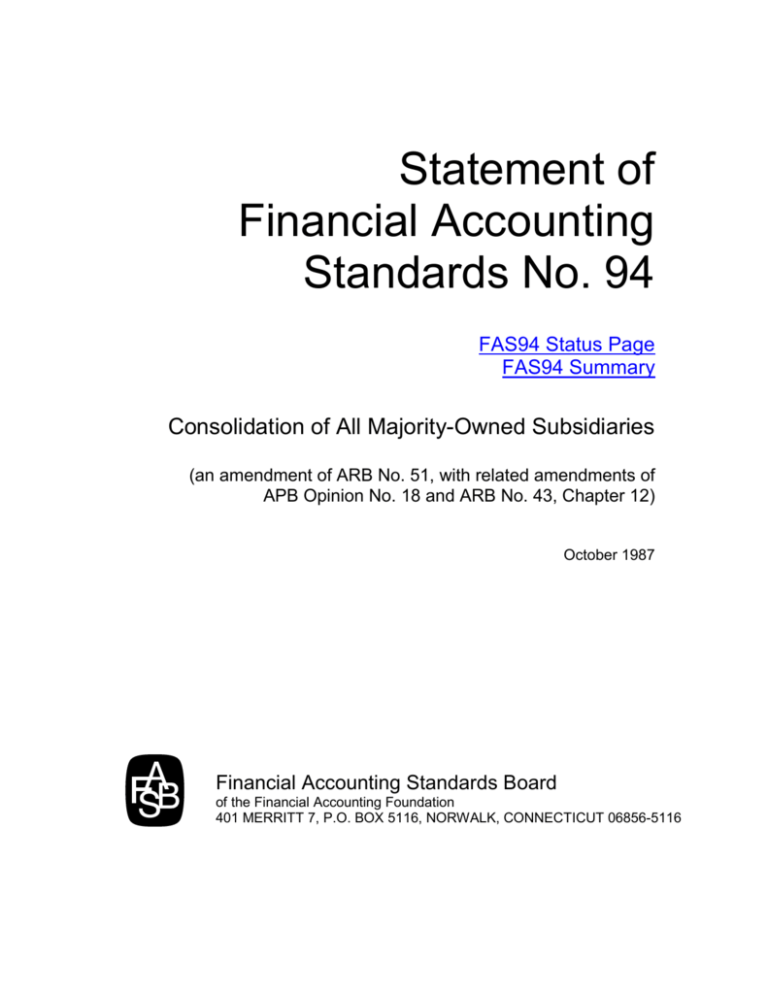
Statement of
Financial Accounting
Standards No. 94
FAS94 Status Page
FAS94 Summary
Consolidation of All Majority-Owned Subsidiaries
(an amendment of ARB No. 51, with related amendments of
APB Opinion No. 18 and ARB No. 43, Chapter 12)
October 1987
Financial Accounting Standards Board
of the Financial Accounting Foundation
401 MERRITT 7, P.O. BOX 5116, NORWALK, CONNECTICUT 06856-5116
Copyright © 1987 by Financial Accounting Standards Board. All rights reserved. No
part of this publication may be reproduced, stored in a retrieval system, or transmitted, in
any form or by any means, electronic, mechanical, photocopying, recording, or
otherwise, without the prior written permission of the Financial Accounting Standards
Board.
Page 2
Statement of Financial Accounting Standards No. 94
Consolidation of All Majority-owned Subsidiaries
an amendment of ARB No. 51, with related amendments of APB Opinion No. 18 and ARB
No. 43, Chapter 12
October 1987
CONTENTS
Paragraph
Numbers
Introduction ................................................................................................................ 1–12
Consolidation ....................................................................................................... 9–10
Continued Disclosure ......................................................................................... 11–12
Standards of Financial Accounting and Reporting:
Amendments of ARB No. 51, APB Opinion No. 18, and
ARB No. 43, Chapter 12 .................................................................................. 13–16
Effective Date and Transition................................................................................... 17
Appendix A: Background Information.................................................................... 18–24
Appendix B: Basis for Conclusions ........................................................................ 25–61
Introduction ........................................................................................................ 25–27
Highly Diverse and Complex Business Enterprises........................................... 28–33
Objectives and Qualitative Characteristics......................................................... 34–44
Relevance and Representational Faithfulness .............................................. 35–41
Comparability............................................................................................... 42–43
Reporting of Cash Flows.................................................................................... 44
Matters Raised in Comment Letters and at the Public Hearing ......................... 45–59
Need for Disaggregated Information............................................................ 54–59
Benefits and Costs of Consolidating All Majority-owned Subsidiaries................... 60
Parent-Company Financial Statements .................................................................... 61
Copyright © 1987, Financial Accounting Standards Board
Not for redistribution
Page 3
FAS 94: Consolidation of All Majority-Owned Subsidiaries
an amendment of ARB No. 51, with related amendments of APB
Opinion No. 18 and ARB No. 43, Chapter 12
FAS 94 Summary
This Statement amends ARB No. 51, Consolidated Financial Statements, to require
consolidation of all majority-owned subsidiaries unless control is temporary or does not rest with
the majority owner. This Statement requires consolidation of a majority-owned subsidiary even
if it has "nonhomogeneous" operations, a large minority interest, or a foreign location.
This Statement also makes certain related amendments to APB Opinion No. 18, The
Equity Method of Accounting for Investments in Common Stock, and to ARB No. 43, Chapter 12,
"Foreign Operations and Foreign Exchange." Among other changes, those amendments preclude
use of parent-company financial statements prepared for issuance to stockholders as the financial
statements of the primary reporting entity.
This Statement requires that summarized information about the assets, liabilities, and
results of operations (or separate statements) of previously unconsolidated majority-owned
subsidiaries continue to be provided after those subsidiaries are consolidated.
This Statement is effective for financial statements for fiscal years ending after December
15, 1988. Restatement of comparative financial statements for earlier years is required.
INTRODUCTION
1.
Accounting Research Bulletin No. 51, Consolidated Financial Statements, adopted by the
Committee on Accounting Procedure of the AICPA in 1959, concisely describes the purpose of
consolidated financial statements in its first paragraph.
The purpose of consolidated statements is to present, primarily for the benefit
of the shareholders and creditors of the parent company, the results of operations
and the financial position of a parent company and its subsidiaries essentially as if
the group were a single company with one or more branches or divisions. There
Copyright © 1987, Financial Accounting Standards Board
Not for redistribution
Page 4
is a presumption that consolidated statements are more meaningful than separate
statements and that they are usually necessary for a fair presentation when one of
the companies in the group directly or indirectly has a controlling financial
interest in the other companies.
2.
Similarly, the first sentence of paragraph 2 describes its general rule of consolidation
policy.
The usual condition for a controlling financial interest is ownership of a
majority voting interest, and, therefore, as a general rule ownership by one
company, directly or indirectly, of over fifty per cent of the outstanding voting
shares of another company is a condition pointing toward consolidation.
3.
While ARB 51's general rule is to consolidate all majority-owned subsidiaries, its
paragraphs 2 and 3 describe "exceptions to that general rule."
4.
Paragraph 2 precludes consolidation of a majority-owned subsidiary under two
conditions—"where control is likely to be temporary, or where it does not rest with the majority
owners (as, for instance, where the subsidiary is in legal reorganization or in bankruptcy)." It
also permits exclusion from consolidation of a subsidiary having a relatively large minority
interest and of a foreign subsidiary.1
5.
The exception in paragraph 3 of ARB 51 has become the basis for excluding from
consolidation the greatest number of majority-owned subsidiaries. It has often been called
exclusion of "nonhomogeneous" operations because of its wording:
. . . even though a group of companies is heterogeneous in character, it may be
better to make a full consolidation than to present a large number of separate
statements. On the other hand, separate statements or combined statements would
be preferable for a subsidiary or group of subsidiaries if the presentation of
financial information concerning the particular activities of such subsidiaries
would be more informative to shareholders and creditors of the parent company
than would the inclusion of such subsidiaries in the consolidation. For example,
separate statements may be required for a subsidiary which is a bank or an
insurance company and may be preferable for a finance company where the
parent and the other subsidiaries are engaged in manufacturing operations.
6.
Business enterprises have increasingly used "nonhomogeneity" as a basis for excluding
from consolidation majority-owned (even wholly owned) subsidiaries considered different in
character from the parent and its other affiliates. Subsidiaries most commonly not consolidated
on that basis have been finance, insurance, real estate, and leasing subsidiaries of manufacturing
and merchandising enterprises.
Copyright © 1987, Financial Accounting Standards Board
Not for redistribution
Page 5
7.
However, certain diversified enterprises consolidate all of their majority-owned
subsidiaries despite differences in their operations, and significant questions about the
"nonhomogeneity" exception have arisen. Present practice has been criticized not only because
apparently similar enterprises use different consolidation policies but also because excluding
some subsidiaries from consolidation results in the omission of significant amounts of assets,
liabilities, revenues, and expenses from the consolidated statements of many enterprises.
Omissions of large amounts of liabilities, especially those of finance and similar subsidiaries,
have led to the criticism that not consolidating those subsidiaries is an important factor in what is
often called "off-balance-sheet financing."
8.
The "nonhomogeneity" exception has only relatively recently become the most prominent
reason for excluding majority-owned subsidiaries from consolidation. When ARB 51 was
issued, other restrictive consolidation policies—to consolidate only wholly owned subsidiaries,
only subsidiaries owned to a specified degree (such as 66 2/3 percent, 75 percent, or 80 percent),
only domestic subsidiaries, only North American subsidiaries, and the like—were more
common. Those other restrictive policies have become less widely used while exclusion for
"nonhomogeneity" has become more widespread.
Consolidation
9.
This Statement eliminates three exceptions to the general rule that majority-owned
subsidiaries should be consolidated: the exceptions for "nonhomogeneous" operations, for
relatively large minority interests (which apparently is seldom used in practice), and for other
restrictive policies. It amends ARB No. 43, Chapter 12, "Foreign Operations and Foreign
Exchange," to narrow the exception for a majority-owned foreign subsidiary from one that
permits exclusion from consolidation of any or all foreign subsidiaries to one that effectively
eliminates distinctions between foreign and domestic subsidiaries.
10.
The other exceptions noted in paragraph 4—control that is likely to be temporary and
control that does not rest with the majority owner because of, for example, corporate
reorganization or bankruptcy—have not been reconsidered in this Statement. They relate to the
concept of control and its place in consolidation policy, which are not within the scope of this
Statement but are part of a broader FASB project on the reporting entity, including
consolidations and the equity method (paragraphs 19 and 20). Similarly, consolidation of
subsidiaries controlled by means other than ownership of a majority voting interest—control by
significant minority ownership, by contract, lease, or agreement with other stockholders, by
court decree, or otherwise—has not been reconsidered in this Statement because that subject also
is part of the project on the reporting entity.
Continued Disclosure
11.
The FASB project on the reporting entity, including consolidations and the equity method,
Copyright © 1987, Financial Accounting Standards Board
Not for redistribution
Page 6
will consider what disaggregated information should be disclosed with consolidated financial
statements. To prevent loss in the meantime of information about unconsolidated subsidiaries
now required by APB Opinion No. 18, The Equity Method of Accounting for Investments in
Common Stock, this Statement requires continued disclosure of that information for subsidiaries
that are consolidated as a result of this Statement.
12. The time between issuance of this Statement and one that would require disclosure of
specified disaggregated information provides an opportunity for business enterprises to explore
ways to provide additional information that is useful to investors, creditors, and others in
understanding and assessing the effects of the differing risks and returns of various activities. A
number of enterprises have been providing information about consolidated subsidiaries that goes
beyond that required by Opinion 18 and FASB Statement No. 14, Financial Reporting for
Segments of a Business Enterprise, and the Board encourages them to continue with and to strive
to improve that disclosure and encourages others to follow their example. That experimentation
not only should result in improved disclosure but also will provide the Board and its constituents
with experience on which to draw in considering the broad issue of disclosures of disaggregated
information.
STANDARDS OF FINANCIAL ACCOUNTING AND REPORTING
Amendments of ARB No. 51, APB Opinion No. 18, and ARB No. 43, Chapter 12
13.
Paragraphs 2 and 3 of ARB 51 are amended to read:2
2. The usual condition for a controlling financial interest is ownership of a majority
voting interest, and, therefore, as a general rule ownership by one company, directly or
indirectly, of over fifty percent of the outstanding voting shares of another company is a
condition pointing toward consolidation. However, there are exceptions to this general
rule. A majority-owned subsidiary shall not be consolidated if control is likely to be
temporary or if it does not rest with the majority owner (as, for instance, if the subsidiary
is in legal reorganization or in bankruptcy or operates under foreign exchange
restrictions, controls, or other governmentally imposed uncertainties so severe that they
cast significant doubt on the parent's ability to control the subsidiary).
3. All majority-owned subsidiaries—all companies in which a parent has a controlling
financial interest through direct or indirect ownership of a majority voting interest—shall
be consolidated except those described in the last sentence of paragraph 2.
14. The heading "Unconsolidated Subsidiaries in Consolidated Statements" and paragraphs
19-21 of ARB 51 are deleted and replaced by the following heading and new paragraph 19:
Copyright © 1987, Financial Accounting Standards Board
Not for redistribution
Page 7
DISCLOSURE ABOUT FORMERLY UNCONSOLIDATED
MAJORITY-OWNED SUBSIDIARIES
19. Information that was disclosed under APB Opinion No. 18, paragraph 20(c), about
majority-owned subsidiaries that were unconsolidated in financial statements for fiscal
years 1986 or 1987 shall continue to be disclosed for them after they are consolidated
pursuant to the provisions of this pronouncement as amended by FASB Statement No.
94. That is, summarized information about the assets, liabilities, and results of operations
(or separate statements) shall be provided for those subsidiaries, either individually or in
groups, as appropriate, in the consolidated financial statements or notes.
15. Opinion 18 is amended to eliminate its requirement to use the equity method to account in
consolidated financial statements for unconsolidated majority-owned subsidiaries and to
eliminate its provisions applying to "parent-company financial statements prepared for issuance
to stockholders as the financial statements of the primary reporting entity," which are precluded
by this Statement.3 The paragraphs primarily affected are 1, 14, 16, and 17 and the footnotes to
them; changes in other paragraphs primarily remove "subsidiaries" or "unconsolidated
subsidiaries" from expressions such as "subsidiaries, joint ventures, and other investees which
qualify for the equity method" or remove other words or sentences that no longer apply.4
a.
The second sentence of paragraph 1 is amended to read:
This Opinion extends the applicability of the equity method of accounting (paragraph
6(b)) to investments in common stock of corporate joint ventures and certain other
investments in common stock.
The third sentence and footnote 1 are deleted.
b.
Footnote 3 to paragraph 4 is amended to read:
See paragraphs 2 and 3 of ARB No. 51 as amended by FASB Statement No. 94.
c.
Paragraph 14 is amended to read:
14. ARB No. 51, paragraphs 2 and 3 (as amended by FASB Statement No. 94), requires
consolidation of all majority-owned subsidiaries except the few that meet conditions
described in paragraph 2. The equity method is not a valid substitute for consolidation.
Moreover, since ARB No. 51 as amended requires the general-purpose financial
statements of companies having one or more majority-owned subsidiaries to be
consolidated statements, parent-company statements are not a valid substitute for
consolidated financial statements.4
Copyright © 1987, Financial Accounting Standards Board
Not for redistribution
Page 8
d.
Paragraph 14, footnote 4, is amended to read:
Paragraphs 2 and 3 of ARB No. 51 (as amended by FASB Statement No. 94) describe the
conditions under which a majority-owned subsidiary shall not be consolidated. The
limitations in paragraphs 2 and 3 of ARB No. 51 (as amended by FASB Statement No.
94) should also be applied as limitations to the use of the equity method.
e.
The second sentence of paragraph 16 is amended to read:
Therefore, investors should account for investments in common stock of corporate joint
ventures by the equity method in consolidated financial statements.6
f.
g.
h.
i.
j.
k.
The last sentence of paragraph 17 is deleted.
The first two sentences of paragraph 19 are deleted.
In the third sentence of paragraph 19, the words "unconsolidated subsidiaries" are deleted.
In the first sentence of paragraph 19(a), the word "subsidiary" is deleted.
Paragraph 20(c) is deleted.
Paragraph 20(d) is amended to delete "of 50% or less" from the first sentence.
16. Paragraphs 8 and 9 of ARB 43, Chapter 12, "Foreign Operations and Foreign Exchange,"
are deleted. (Paragraph 8 and part of 9 are quoted in footnote 1 of this Statement.)
Effective Date and Transition
17. This Statement shall be effective for financial statements for fiscal years ending after
December 15, 1988. Earlier application is encouraged. Application to interim financial
statements for the year of adoption is not required at the time of their issuance; however,
comparative financial statements for earlier periods including those of the year of adoption shall
be restated when this Statement is applied.
The provisions of this Statement need
not be applied to immaterial items.
This Statement was adopted by the affirmative votes of six members of the Financial
Accounting Standards Board. Mr. Brown dissented.
Mr. Brown does not support this Statement's requirement to continue disclosures for
subsidiaries formerly exempt from consolidation. He believes that, although this Statement
improves financial reporting by requiring consolidation of most subsidiaries formerly exempt
from consolidation, the requirement for continued disclosure is not evenhanded and has not been
justified. By requiring continued disclosures for subsidiaries that were not consolidated in 1986
Copyright © 1987, Financial Accounting Standards Board
Not for redistribution
Page 9
and 1987, this Statement would oblige certain business enterprises to disclose information not
required of enterprises in similar circumstances. That additional disclosure would not be based
on different circumstances but merely on differences in past accounting practices.
Mr. Brown believes that comparability of financial statements will not be enhanced by
those disclosure requirements. On the effective date of the Statement, similarly situated
enterprises will have different disclosure requirements. That lack of comparability will increase
over time because the proportion of subsidiaries subject to those requirements will decline. That
decline will occur because newly formed subsidiaries will not be subject to the disclosure
requirements and because the number of subsidiaries for which disclosure is initially required
will decrease over time due to attrition. The disclosure requirements are characterized as
expedient and are expected to be temporary, pending Board consideration of the broad issue of
disclosure of disaggregated activities. Mr. Brown notes, however, that this consideration may be
some years in the future.
The stated purpose of those disclosure requirements is to avoid possible loss of
information previously disclosed. Mr. Brown observes, however, that the importance of the
information that might be lost has not been substantiated, nor is it even clear that significant
information would be lost. Many subsidiaries that are newly required to be consolidated under
this Statement will be segments under FASB Statement No. 14, Financial Reporting for
Segments of a Business Enterprise. For those enterprises, segment reporting will provide
supplementary information. In addition, enterprises may well choose to disclose information
voluntarily as suggested by the fact that many enterprises already provide information about
consolidated subsidiaries that goes beyond existing requirements. Further, Mr. Brown thinks
that enterprises will have strong incentives to provide disclosures to minimize the possibility that
investors, creditors, and others will misinterpret financial statements in which formerly
unconsolidated subsidiaries are consolidated.
Members of the Financial Accounting Standards Board:
Dennis R. Beresford, Chairman
Victor H. Brown
Raymond C. Lauver
James J. Leisenring
David Mosso
C. Arthur Northrop
Robert J. Swieringa
Appendix A: BACKGROUND INFORMATION
18. An AICPA Issues Paper, "Reporting Finance Subsidiaries in Consolidated Financial
Statements," dated December 27, 1978, asked the Board to consider whether finance subsidiaries
of primarily nonfinancial business enterprises should be required to be consolidated. It said that
Copyright © 1987, Financial Accounting Standards Board
Not for redistribution
Page 10
the permitted exclusion of finance companies from consolidated financial statements in ARB 51
should be reevaluated because of the increased number and size of unconsolidated finance
subsidiaries then in existence. Since 1978, unconsolidated finance subsidiaries have continued
to proliferate.
19. The Board added a project on the reporting entity, including consolidations and the equity
method, to its agenda in January 1982. The issues in that AICPA Issues Paper, as well as those
in several others, were included in the scope of the project.
20. A major goal of the project is to develop a reporting entity concept for business
enterprises. Research and deliberation on the reporting entity concept and other consolidation
issues are still in progress. The Board has tentatively concluded that the concept should be based
primarily on control rather than on ownership of a majority voting interest, which is the most
common but not the only means of controlling a subsidiary. However, the Board has not yet
reached agreement on some significant issues, including precisely how to determine if means
other than majority ownership have resulted in control and what techniques of consolidation
would best report the effects of noncontrolling (minority) interests that arise because subsidiaries
are only partially owned. Since more consideration of those matters is needed, the Board's
tentative conclusions on a concept of reporting entity for business enterprises is not yet ready to
be issued.
21. The Board's deliberations on the reporting entity concept have proceeded far enough to
establish that consolidation of all majority-owned subsidiaries whose control is not in question is
consistent with all of the reporting entity concepts that the Board is considering. Therefore, the
Board decided to require consolidation of all majority-owned subsidiaries, because that decision
will not be affected by resolution of the remaining issues.
22. This Statement is a major step in resolving the growing problem of off-balance-sheet
financing. Unconsolidated majority-owned subsidiaries have been a significant aspect of that
problem. The growing size and importance of finance and other unconsolidated majority-owned
subsidiaries and the resulting amounts of assets, liabilities, revenues, and expenses that have not
been reflected in many consolidated financial statements have made the matter important.
23. The Board issued an Exposure Draft, Consolidation of All Majority-owned Subsidiaries,
on December 16, 1986. The Board received 232 letters of comment on the Exposure Draft and
21 individuals and organizations presented their views at a public hearing held on May 18 and
19, 1987.
24. The major difference between this Statement and the Exposure Draft is that the Exposure
Draft proscribed the equity method for investments in majority-owned companies that remain
unconsolidated because of the provisions of paragraph 2 of ARB 51 as amended by this
Statement, while this Statement is silent on that subject. The effective date of the Statement also
is one year later than that in the Exposure Draft.
Copyright © 1987, Financial Accounting Standards Board
Not for redistribution
Page 11
Appendix B: BASIS FOR CONCLUSIONS
Introduction
25. This appendix reviews considerations that were deemed significant by members of the
Board in reaching the conclusions in this Statement. It includes reasons for accepting certain
views and rejecting others. Individual Board members gave greater weight to some factors than
to others.
26. The introduction to this Statement notes that practice under ARB 51 has become
increasingly diverse as some enterprises have consolidated all their significant majority-owned
subsidiaries and other enterprises have excluded some majority-owned subsidiaries from
consolidation. That diversity has been criticized as lessening comparability between enterprises'
financial statements. The introduction also notes that practice has been increasingly criticized as
often omitting significant amounts of assets, liabilities, revenues, and expenses from
consolidated financial statements. That result has made exclusion of some majority-owned
subsidiaries from consolidation a significant factor in off-balance-sheet financing.
27. Most of those criticisms of practice relate to what has commonly been called the
"nonhomogeneity" exception to consolidation of all majority-owned subsidiaries. Significant
majority-owned subsidiaries also have been excluded from consolidation for other reasons, but
the most prevalent exclusions in practice recently have been finance, insurance, real estate,
leasing, and other "nonhomogeneous" subsidiaries by manufacturing and merchandising
enterprises. The basis in the authoritative literature for that "nonhomogeneity" exception has
been the third paragraph of ARB 51 (paragraphs 5-8 of this Statement).
Highly Diverse and Complex Business Enterprises
28. In the 28 years since ARB 51 was issued, business enterprises have continued to become
more diverse and complex. Enterprises have branched into different lines of business and
entered many foreign markets. More enterprises that previously were considered nonfinancial
have been diversifying into financial services—financing, insurance, real estate, leasing, and
investment banking—while more of those that remain primarily nonfinancial enterprises have
been forming separate subsidiaries to carry out financial activities that were formerly carried out
by the parents or their existing subsidiaries.
29. In an economy in which numerous and varied kinds of activities are commonly combined
in a single enterprise, whether organized as a single corporation with branches and divisions or
as a parent company and subsidiaries, the argument that part of an enterprise has operations so
Copyright © 1987, Financial Accounting Standards Board
Not for redistribution
Page 12
different from those of other parts that it should be accounted for in a fundamentally different
way has become increasingly tenuous. The Board concluded that the increasingly diverse nature
of business activity, and of business enterprises themselves, makes the fact that the business
activity of a subsidiary is different from that of its parent and other subsidiaries an insufficient
reason to exclude it from consolidation.
30. The managerial, operational, and financial ties that bind an enterprise into a single
economic unit are stronger than the differences between its lines of business. Consolidated
financial statements became common once it was recognized that boundaries between separate
corporate entities must be ignored to report the business carried on by a group of affiliated
corporations as the economic and financial whole that it actually is. Similarly, differences
between the varied operations of a group of affiliated corporations that constitutes an economic
and financial whole do not preclude including them all in consolidated financial statements.
31. Those differences also do not make the equity method a valid substitute for consolidation
of majority-owned subsidiaries. Although the equity method described in Opinion 18 usually
results in the same net income and the same net assets as consolidation, that method omits
significant revenues and expenses from the income statement, omits significant assets and
liabilities from the balance sheet, and omits significant receipts and payments from the statement
of cash flows. For example, difference in operations has long been rejected as a basis for not
consolidating so-called captive leasing subsidiaries. The decision and most of the language now
in paragraph 31 of FASB Statement No. 13, Accounting for Leases, was in APB Opinion No. 10,
Omnibus Opinion—1966 (and was reaffirmed in Opinion 18):
The accounts of subsidiaries (regardless of when organized or acquired)
whose principal business activity is leasing property or facilities to the parent or
other affiliated companies shall be consolidated. The equity method is not
adequate for fair presentation of those subsidiaries because their assets and
liabilities are significant to the consolidated financial position of the enterprise.
The same reasoning applies to other "nonhomogeneous" majority-owned subsidiaries, whether
captive or not.
32. Other restrictive consolidation practices have been to exclude from consolidation, for
example, all foreign subsidiaries, all subsidiaries that are not wholly owned, or all subsidiaries
that are not 80 percent owned. Those essentially arbitrary restrictions also are not sufficient
reasons to exclude majority-owned subsidiaries from consolidation.
33. The central issue is whether financial statements that consolidate some majority-owned
subsidiaries and report others as investments in the equity securities of other enterprises
adequately report the operating results and financial position of the business enterprise of which
all the subsidiaries are a part. The Board concluded that consolidated financial statements that
include all majority-owned subsidiaries whose control is not in question better meet the
Copyright © 1987, Financial Accounting Standards Board
Not for redistribution
Page 13
objectives of financial reporting and more fully possess the qualitative characteristics of useful
financial information described in FASB Concepts Statement No. 2, Qualitative Characteristics
of Accounting Information, especially relevance, representational faithfulness, and
comparability.
Objectives and Qualitative Characteristics
34. Investors, creditors, and others who use financial statements need information about a
business enterprise that is useful in making investment, credit, or other similar decisions about it
(FASB Concepts Statement No. 1, Objectives of Financial Reporting by Business Enterprises,
paragraphs 34-40). Those who invest in the parent company of an affiliated group of
corporations invest in the whole group, which constitutes the enterprise that is a potential source
of cash flows to them as a result of their investment.
Relevance and Representational Faithfulness
35. Information that is most relevant to investors, creditors, and other users thus includes
consolidated financial statements that "present, primarily for the benefit of the shareholders and
creditors of the parent company, the results of operations and the financial position of a parent
company and its subsidiaries essentially as if the group were a single company with one or more
branches or divisions" (ARB 51, paragraph 1).
36. A set of consolidated financial statements that includes all majority-owned subsidiaries
fits that description better than a set that excludes significant parts of an enterprise. If the assets,
liabilities, revenues, expenses, and cash flows of "nonhomogeneous" subsidiaries are excluded
from consolidation, the consolidated financial statements of the enterprise do not faithfully
represent 5 the operating results, financial status, and capital structure of the enterprise described
in paragraph 35.
37.
A significant aspect of both relevance and representational faithfulness is completeness—
The inclusion in reported information of everything material that is necessary
for faithful representation of the relevant phenomena.
Freedom from bias . . . implies that nothing material is left out of the
information that may be necessary to insure that it validly represents the
underlying events and conditions.
Relevance of information is adversely affected if a relevant piece of
information is omitted, even if the omission does not falsify what is shown.
[Concepts Statement 2, "Glossary," and paragraphs 79 and 80]
Consolidated financial statements that exclude some majority-owned subsidiaries provide an
incomplete picture of an enterprise. If they are to see the complete picture, investors, creditors,
and other users must themselves attempt to consolidate the excluded subsidiaries. Even then, a
Copyright © 1987, Financial Accounting Standards Board
Not for redistribution
Page 14
"do-it-yourself" consolidation can only be a rough approximation of one done by the enterprise
itself because consolidation procedures require detailed information about current amounts and
past transactions that is seldom provided by general-purpose financial reporting. The
representational faithfulness of a user's consolidation is at least questionable, and its
comparability with consolidated financial statements or "do-it-yourself" consolidations of other
enterprises, or of the same enterprise for an earlier period, is at best doubtful.
38. Unconsolidated majority-owned subsidiaries usually have been accounted for by the
equity method in accordance with Opinion 18. The equity method described by Opinion 18
normally results in the same net income and stockholders' equity as consolidation, but the
information it provides about specific classes of assets, liabilities, revenues, and expenses is
significantly different from, and is not a substitute for, information provided by consolidation.
The equity method reports a parent's equity in the net assets of its unconsolidated subsidiaries as
a single-line item in the consolidated statement of financial position and generally reports its
share of the unconsolidated subsidiaries' reported net income as a single-line item in the
consolidated income statement.
39. Although net income and total stockholders' equity are important factors in assessing the
enterprise's performance and its financial position, the relative amounts of various assets,
liabilities, revenues, and expenses and their relationships to other items in the consolidated
financial statements also generally are essential factors in that analysis.
Although ... simplifications, condensations, and aggregations are both
necessary and useful, the Board believes it is important to avoid focusing
attention almost exclusively on "the bottom line," earnings per share, or other
highly simplified condensations. Summary data, such as the amounts of net
assets, comprehensive income, earnings, or earnings per share, may be useful as
general indicators of the amount of investment or overall past performance and
are often used in efforts to compare an entity with many other entities. But, in a
complex business enterprise, summary amounts include many heterogeneous
things and events. Components of a financial statement often reflect more
homogeneous classes of items than the whole statement. The individual items,
subtotals, or other parts of a financial statement may often be more useful than the
aggregate to those who make investment, credit, and similar decisions. [FASB
Concepts Statement No. 5, Recognition and Measurement in Financial Statements
of Business Enterprises, paragraph 22]
40. The usefulness of information about amounts of various assets, liabilities, revenues, and
expenses is also indicated by the fact that most summary indicators other than net income,
earnings per share, and stockholders' equity are affected by whether a subsidiary is consolidated
or accounted for by the equity method. Basic analytical tools such as the current ratio,
receivables turnover, inventory turnover, times interest earned, and return on total assets are a
few examples. The paramount example is the debt-equity ratio, which, for reasons already
Copyright © 1987, Financial Accounting Standards Board
Not for redistribution
Page 15
described, is much lower if finance or other highly leveraged subsidiaries are accounted for by
the equity method rather than consolidated. That effect is one aspect of off-balance-sheet
financing that has been criticized because transactions between affiliates and intercompany
receivables and payables often make it unlikely that "do-it-yourself" consolidation can
adequately approximate debt-equity ratios in consolidated financial statements provided by the
enterprises themselves.
41. Use of the equity method for majority-owned subsidiaries that are significant parts of an
enterprise diminishes the usefulness of and raises questions about the credibility of consolidated
financial statements as those subsidiaries grow in significance. As enterprises become more
diversified, the number and variety of their majority-owned subsidiaries that are not consolidated
because of "nonhomogeneity" of operations often increase. Thus, the amounts reported as
single-line items in consolidated financial statements not only become larger but also the
information they convey diminishes—the resulting consolidated financial statements provide
less and less information about the enterprise in which its stockholders have invested.
Consolidated financial statements of some enterprises have excluded more assets and liabilities
than they have included.
Comparability
42. Consolidation of all majority-owned subsidiaries will also improve comparability between
enterprises. Investment and credit decisions involve comparing available alternative investment
or credit opportunities. Thus:
Information about an enterprise gains greatly in usefulness if it can be
compared with similar information about other enterprises and with similar
information about the same enterprise for some other period or some other point
in time. The significance of information, especially quantitative information,
depends to a great extent on the user's ability to relate it to some benchmark.
[Concepts Statement 2, paragraph 111]
43. As Concepts Statement 2 also notes (paragraphs 113-119), comparison involves
identifying, understanding, and assessing both similarities and differences. To the extent that
similarities and differences stem from financial reporting rather than from the enterprises
themselves, financial reporting hinders rather than helps investors and creditors in making their
decisions. A significant problem in practice under ARB 51 is that large differences between
consolidated financial statements of different business enterprises often have resulted from
different consolidation policies rather than from significant differences between the enterprises.
Reporting of Cash Flows
44. Consolidated financial statements that include all majority-owned subsidiaries should also
result in more relevant, representationally faithful, and comparable statements of cash flow.
Although the equity method and consolidation may report the same net income and net assets,
Copyright © 1987, Financial Accounting Standards Board
Not for redistribution
Page 16
they do not report the same cash receipts and payments related to operating, investing, and
financing activities. Potentially significant information about how an enterprise generates cash
through operations, as well as information about its financing and investing activities, is not
provided if subsidiaries are not consolidated.
Matters Raised in Comment Letters and at the Public Hearing
45. Many respondents who opposed the conclusion of the Exposure Draft argued that
consolidation of "nonhomogeneous" subsidiaries would make the consolidated financial
statements less useful. Many asserted that it would impair comparability of the financial data
between enterprises and that it would confuse the expected debt-equity (and other) ratios of
manufacturing and financial components of diverse business enterprises, resulting in ratios that
would accurately reflect neither component. On the other hand, many respondents who
supported the conclusion of the Exposure Draft did so because they thought comparability would
be enhanced due to more comprehensive disclosure of financial results.
46. Before the Exposure Draft was issued, the Board recognized that opinions of respondents
on whether consolidated financial statements were more useful probably would be divided. The
Board considered the comments on usefulness with emphasis on comparability and noted that
usefulness means more than comparability. The Board's conclusions rely on Concepts Statement
2, which emphasizes relevance and representational faithfulness as much as comparability.
Thus, the Board concluded that consolidated financial statements that include all majority-owned
subsidiaries whose control is not in question better meet the objectives of financial reporting.
47. Most respondents who opposed the elimination of the "nonhomogeneity" exception
acknowledged that it needed some boundaries. Some proposed that finance and insurance
subsidiaries ought to be excluded from consolidation by nonfinancial enterprises and suggested
the Board establish criteria for excluding certain subsidiaries by examining differences in
reported financial ratios or in the operating cycles. Respondents did not suggest a basis for
determining threshold values for those criteria, and the Board observed that any choice
necessarily would be arbitrary, would differ between industries, and could vary over time due to
changes in business practices. Some measures that seem appropriate may not distinguish
effectively between subsidiaries. For example, a high debt-equity ratio may reflect either poor
financial condition, "nonhomogeneity," or both. The Board concluded that establishing criteria
for "nonhomogeneity" based on financial characteristics would be arbitrary and ineffective.
48. Other respondents suggested that the Board narrow the "nonhomogeneity" exception by
requiring consolidation of all "captive" subsidiaries—that is, subsidiaries that conduct a majority
of their transactions with their parent company. Those respondents argued that consolidating
captive subsidiaries improves comparability with enterprises that have not formed subsidiaries
but engage in like activities. They argued that consolidating noncaptive, "nonhomogeneous"
subsidiaries impairs that comparability. Respondents suggested that the Board look to a
subsidiary's relationship to the primary reporting entity to distinguish captive from noncaptive.
Copyright © 1987, Financial Accounting Standards Board
Not for redistribution
Page 17
The Board observed that as diversification increases so does the difficulty of identifying the
primary business of an enterprise. Respondents were unable to provide substantive guidelines
for that identification. The Board agreed with respondents that, if a subsidiary is captive,
consolidation of that subsidiary improves comparability. However, the Board concluded that
other arguments including improved representational faithfulness and relevance justify
consolidating noncaptive subsidiaries.
49. Many respondents criticized the Exposure Draft's requirements as representing a
"piecemeal" approach to establishing revised consolidation criteria. Most indicated that such an
approach created a risk that future decisions by the Board may require the consolidation
requirements of the Exposure Draft to be reversed. The Board recognizes that deliberation will
continue on the reporting entity concept, which may lead to changed consolidation criteria based
on control. However, the Board concluded that the risk of reversing the consolidation
requirements of this Statement was minimal because the criteria for excluding subsidiaries from
consolidation based on "nonhomogeneity" are unrelated to control.
50. Some respondents recommended that the Board provide guidance for various financial
statement display questions that may arise, including how to consolidate a nonclassified
statement of financial position used by a financial institution with a classified statement of
financial position used by a manufacturing or merchandising company and how to display
interest expense of both financial and manufacturing subsidiaries in a consolidated income
statement. The Board noted that guidance might reduce diversity of display but concluded that
some variety may be appropriate for reporting the financial position and results of diverse
enterprises. The Board also noted that the issue is not new because some enterprises have
consolidated subsidiaries with those characteristics and have developed reporting formats to
present consolidated results effectively.
51. Many respondents requested a delay in the effective date. The most compelling reasons
offered for extending the effective date were the need to allow companies additional time to
renegotiate loan covenants or other provisions of loan agreements and to familiarize investors,
creditors, and other users with the effects of consolidation on financial statement ratios.
Respondents indicated that the risk of increased cost of borrowing at the time loan covenants are
renegotiated would be mitigated if additional time was available. Respondents also requested
additional time to determine the most effective financial statement display. The Board accepted
those arguments and delayed the effective date for one year.
52. Several respondents questioned whether direct financing and leveraged leases of a
majority-owned leasing subsidiary accounted for under the equity method would be required to
be reclassified as sales-type capital leases when the subsidiary is consolidated. Paragraph 19 of
Opinion 18, which specifies how to account for those subsidiaries under the equity method prior
to their being consolidated as required by this Statement, indicated that net income and
stockholders' equity generally would be the same whether the subsidiary was accounted for
under the equity method or whether it was consolidated. Thus, whether a leasing subsidiary was
Copyright © 1987, Financial Accounting Standards Board
Not for redistribution
Page 18
accounted for by the equity method or is now consolidated as required by this Statement, the
distinction between a direct financing and a sales-type capital lease is based on application of
Statement 13 as if the subsidiary were consolidated. Leases of a manufacturing company's
equipment sold to a leasing subsidiary that are accounted for as direct financing leases on the
subsidiary's financial statements normally would be sales-type capital leases in the consolidated
financial statements. This Statement does not change that requirement.
53. The Exposure Draft's requirement to use the cost method for majority-owned subsidiaries
that remain unconsolidated was intended to change Opinion 18 only to the extent necessary to
avoid conflict with ARB 51 as amended. However, respondents said that the requirement would
change practice because "significant influence" might remain even if control were lost and
because of specialized industry practices for investment companies. The Board removed the
requirement to use only the cost method, thereby leaving existing pronouncements in effect. The
method to be used to account for those subsidiaries will be considered in the broad project
described in paragraphs 19 and 20.
Need for Disaggregated Information
54. Some who favor consolidating all majority-owned subsidiaries whose control is not in
question are nevertheless concerned that consolidating "nonhomogeneous" subsidiaries will
obscure important information about the primary operations of an enterprise, producing less
informative financial statements than those that exclude "nonhomogeneous" subsidiaries but
append their separate financial statements or equivalent information. An example is a parent that
is primarily a manufacturing enterprise that consolidates an insurance or bank subsidiary. That
concern was expressed frequently in interviews conducted in the early stages of the FASB
project on the reporting entity (paragraphs 19 and 20), both by those who use financial
statements and by those who provide them.
55. The Board recognizes that aggregation of assets and liabilities resulting from operations
with activities that differ from each other in profitability, risks, and returns can obscure
important information about each of those activities. However, the Board also believes that
disclosures required under FASB Statement No. 14, Financial Reporting for Segments of a
Business Enterprise, can provide meaningful information about the different operations within a
business enterprise. Consolidated financial statements and adequate disclosure of varied
activities are not mutually exclusive.
56. The financial reporting that has followed the issuance of Statement 14 in 1976 has
demonstrated that financial reporting can readily provide both consolidated and disaggregated
information. For example, when the Securities and Exchange Commission eliminated its
requirement to provide separate financial statements of consolidated subsidiaries engaged in
"diverse financial-type" businesses in 1981, it said, "The Commission's decision to delete all
requirements for additional financial information for consolidated finance-type subsidiaries...was
significantly influenced by its conclusion that the disclosures required by [FASB Statement] 14
Copyright © 1987, Financial Accounting Standards Board
Not for redistribution
Page 19
provide adequate information on these activities to most investors..." (Accounting Series
Release No. 302, Separate Financial Statements Required by Regulation S-X).
57. The broad project on the reporting entity will consider disclosure of disaggregated
information in consolidated financial statements. Business enterprises have the opportunity to
experiment with providing additional information in the time between the issuance of this
Statement and the completion of that portion of the broader project. The Board encourages
experimentation to improve disclosure and to better communicate to investors, creditors, and
others. That experimentation should prove beneficial to the preparer and should provide the
Board and others with experience that is useful when considering disclosure of disaggregated
information in the future.
58. Opinion 18, paragraph 20(c) has required that summarized information about the assets,
liabilities, and results of operations of unconsolidated subsidiaries should be presented in the
notes of consolidated financial statements or in separate statements. Some of that information is
not required by Statement 14. Many comments were received on the general issue of disclosing
disaggregated information. Recommendations ranged from requiring no disclosure to requiring
consolidating financial statements. Although opposition to the requirement to continue
disclosure presently called for by Opinion 18 was substantial, some suggested less information
should be required, while others said more, or at least different, information should be required.
Users of financial statements expressed strong concern about the possible loss of information
that was currently available.
59. The Board acknowledges that this Statement's disclosure requirement represents an
expedient solution. The Board concluded, however, that alternatives were less attractive.
Increasing disclosure requirements to eliminate what is perceived as this Statement's lack of
evenhandedness without reconsidering the broad issue of disclosing disaggregated information
probably would not result in meaningful requirements. Dropping that requirement would result
in loss of information that users of financial statements urged the Board to retain. The Board
concluded that to prevent loss of that information was important. The Board also noted that the
requirement is reasonably evenhanded. Most enterprises with what generally have been called
"nonhomogeneous" subsidiaries will be required to provide continued disclosure because most of
those subsidiaries are not now consolidated. Moreover, the Board recognized that many
enterprises would voluntarily provide the disaggregated information they thought necessary to
meet concerns they expect to result from the revised consolidation policy. Those enterprises
would incur no additional cost to implement the disclosure provision of this Statement. After
assessing the matters set forth in this and the previous paragraph, the Board decided to continue
Opinion 18's disclosure requirements for subsidiaries that are consolidated as a result of this
Statement.
Benefits and Costs of Consolidating All Majority-owned Subsidiaries
60.
Paragraphs 25-44 discuss the benefits of requiring consolidation of all majority-owned
Copyright © 1987, Financial Accounting Standards Board
Not for redistribution
Page 20
subsidiaries whose control is not in question. The Board recognizes that initial adoption of that
requirement may cause some enterprises to incur certain costs, for example, to renegotiate debt
covenants that are technically in default once highly leveraged finance and similar subsidiaries
are consolidated and perhaps to educate some investors and creditors about the change in
consolidation policy. However, the Board believes that those costs will be outweighed by the
benefits of more relevant, representationally faithful, and comparable consolidated financial
statements.
Parent-Company Financial Statements
61. Opinion 18, paragraphs 14, 16, and 17, requires use of the equity method in
"parent-company financial statements prepared for issuance to stockholders as the financial
statements of the primary reporting entity." This Statement removes those provisions because, if
an enterprise has one or more subsidiaries, consolidated rather than parent-company financial
statements are the appropriate general-purpose financial statements. The Board is aware of no
instances in which parent-company financial statements have been issued as general-purpose
financial statements and believes the elimination of those provisions will result in little or no
change in practice.
Copyright © 1987, Financial Accounting Standards Board
Not for redistribution
Page 21
Footnotes
FAS94, Footnote 1--Paragraph 2 permits omission of majority-owned foreign subsidiaries from
consolidation by reference to the broad provisions of ARB No. 43, Chapter 12, "Foreign
Operations and Foreign Exchange," paragraphs 8 and 9:
In view of the uncertain values and availability of the assets and net income of
foreign subsidiaries subject to controls and exchange restrictions and the
consequent unrealistic statements of income that may result from the translation
of many foreign currencies into dollars, careful consideration should be given to
the fundamental question of whether it is proper to consolidate the statements of
foreign subsidiaries with the statements of United States companies. Whether
consolidation of foreign subsidiaries is decided upon or not, adequate disclosure
of foreign operations should be made.
The following are among the possible ways of providing information relating to
such foreign subsidiaries:
a. To exclude foreign subsidiaries from consolidation and to furnish (1) statements in which
only domestic subsidiaries are consolidated and (2) as to foreign subsidiaries, a summary in
suitable form of their assets and liabilities, their income and losses for the year, and the parent
company's equity therein. . . .
FAS94, Footnote 2--Details of the changes: Paragraph 2 of ARB 51 is amended to delete the
fourth, fifth, and sixth sentences and to delete "For example," to change "should" to "shall," and
to add an example in the parentheses in the third sentence. The deleted sentences read: "There
may also be situations where the minority interest in the subsidiary is so large, in relation to the
equity of the shareholders of the parent in the consolidated net assets, that the presentation of
separate financial statements for the two companies would be more meaningful and useful.
However, the fact that the subsidiary has a relatively large indebtedness to bondholders or others
is not in itself a valid argument for exclusion of the subsidiary from consolidation. (Also, see
Chapter 12 of Accounting Research Bulletin No. 43 for the treatment of foreign subsidiaries.)"
Paragraph 3 (most of which is quoted in paragraph 5 of this Statement) is entirely deleted and
replaced by a new paragraph 3.
FAS94, Footnote 3--Opinion 18 was silent about parent-company financial statements prepared
for purposes other than issuance as the general-purpose financial statements of the primary
reporting entity. This Statement also does not consider that subject.
FAS94, Footnote 4--Details of major changes: Paragraphs 1, 16, and 17--The deleted parts of
all three paragraphs pertain to "parent-company financial statements prepared for issuance to
stockholders as the financial statements of the primary reporting entity." A similar provision is
also deleted from paragraph 14. Paragraph 14--The first sentence, "The Board reaffirms the
Copyright © 1987, Financial Accounting Standards Board
Not for redistribution
Page 22
conclusion that investors should account for investments in common stock of unconsolidated
domestic subsidiaries by the equity method in consolidated financial statements, and the Board
now extends this conclusion to investments in common stock of all unconsolidated subsidiaries
(foreign as well as domestic) in consolidated financial statements," and the third sentence (whose
content was just described) are deleted and replaced by new sentences. In the second sentence
the words "and should not be used to justify exclusion of a subsidiary when consolidation is
otherwise appropriate" are deleted. Paragraph 19--The deleted sentences read: "The difference
between consolidation and the equity method lies in the details reported in the financial
statements. Thus, an investor's net income for the period and its stockholders' equity at the end
of the period are the same whether an investment in a subsidiary is accounted for under the equity
method or the subsidiary is consolidated (except as indicated in paragraph 19i)."
FAS94, Appendix B, Footnote 5--"Representational faithfulness is correspondence or agreement
between a measure or description and the phenomenon it purports to represent. In accounting,
the phenomena to be represented are economic resources and obligations and the transactions and
events that change those resources and obligations" (Concepts Statement 2, par. 63).
Copyright © 1987, Financial Accounting Standards Board
Not for redistribution
Page 23

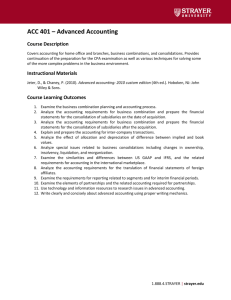
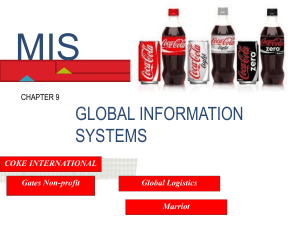
![[DOCX 51.43KB]](http://s3.studylib.net/store/data/007172908_1-9fbe7e9e1240b01879b0c095d6b49d99-300x300.png)
